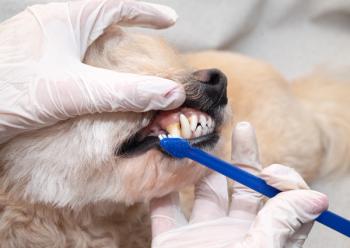
- Firstline July/August 2020
- Volume 16
- Issue 4
Make the conversation about dental health memorable
As a veterinary professional, you know how important your patients’ oral health is, but are your clients aware? Check out these tips on how to have a meaningful conversation with your clients about dental health.
Every member of your veterinary team should be able to confidently advocate for pet dental health. Not sure where to start? Consider these suggestions for making actionable recommendations in the examination room and promoting ongoing oral care at home.
Address dental care during every well visit
Vow to not skip the conversation
During wellness visits, be diligent about making dental health discussions as routine as taking a patient’s vital signs. When technicians initiate a conversation about a pet's dental needs, it adds substantial weight when the veterinarian repeats the same points later in the visit.
Present the facts
Make sure clients are aware of how common dental issues are in companion animals. Although dental issues are not always apparent to pet owners, 80% to 89% of dogs1 and about 70% cats2 have some level of periodontal disease by the age of three.
Help clients understand that dental disease can cause pain and infection that, left untreated, will decrease their pet’s quality of life. Send your message home by providing real-life examples, such as a photos or radiographs comparing healthy and diseased teeth. Make sure clients know that, as for people, dental disease in pets is irreversible, but treatments are available to rectify problems. The intent is not to instill fear, but rather to help clients understand the full scope of the situation.
Make concrete recommendations
Too often clients perceive discussions about their pet’s oral health as “friendly suggestions” instead of medical recommendations. Consider how you approach the conversation and what small, impactful changes you can make to improve compliance. For example, rather than saying simply, “You should consider scheduling a dental appointment for Fido soon,” reiterate specific concerns (e.g. gingival recession, tooth fracture) from the exam and explain that you would like to schedule a full dental exam under anesthesia so the veterinarian can make a proper diagnosis.
Share experiences among staff
Put “conversations with clients about dental care” on the agenda for your next staff meeting, and take the opportunity to share real-life experiences with one another. Discuss what tactics work best with clients and how to move beyond the common pushbacks. Evaluate the feedback and, as a group, come up with brief yet compelling recommendations that staff can make to clients about dental care.
Stress the importance of home dental care
Maintaining proper pet oral health cannot be done solely during annual visits at the veterinary hospital. As for people, regular toothbrushing is the best way to prevent periodontal disease in pets.3,4 It’s imperative that clients take the lead on cleaning their pets’ mouths and recognizing signs of pain or disease. The key to increasing compliance is keeping it simple. Here are five ways to keep your clients informed in and out of the hospital:
- Explain in detail how to start the toothbrushing process and what products to use to ensure a pleasant experience for both pet and owner.
- Maintain and distribute client handouts based on individual patients, such as young pets, cats, dogs with gingivitis, etc. (Hint: For a plethora of handouts on a wide range of topics, including pet dental health, visit
dvm360.com/business/client-handouts .) - Keep the conversation going online by using your hospital’s social media platforms to educate clients about the need for preventive care. Aim to share at least one post a week.
- Provide clients with specific oral health product recommendations, including those with the
Veterinary Oral Health Council Seal of Acceptance . - Include links to dental health articles in any post-appointment notes that are sent to clients.
And be sure to follow up after a dental procedure to see if the client has any questions about postoperative care or long-term maintenance.
References
- Brunius Enlund K, Brunius C, Hanson J, et al. Dental home care in dogs - a questionnaire study among Swedish dog owners, veterinarians and veterinary nurses. BMC Vet Res.2020; 16: 90.
- Brook AN. Veterinary Periodontology. Ames: Wiley-Blackwell; 2013.
- Harvey C, Serfilippi L, Barnvos D. Effect of frequency of brushing teeth on plaque and calculus accumulation, and gingivitis in dogs. J Vet Dent. 2015;32:16-21.
- Gorrel C, Rawlings JM. The role of tooth-brushing and diet in the maintenance of periodontal health in dogs. J Vet Dent. 1996;13:139-143.
Amanda Carrozza is a freelance writer and editor in New Jersey.
Articles in this issue
over 5 years ago
Ask Emily: Do I need a monthly staff meeting?almost 6 years ago
A practical review of common veterinary renal toxinsalmost 6 years ago
Laser pointers can cause behavior disorders in catsalmost 6 years ago
Rodeo: When patient fear makes a veterinary exam nearly impossibleabout 6 years ago
How the human-animal bond is reshaping veterinary careabout 6 years ago
Your kitten foster care program needs a manualabout 6 years ago
A primer on veterinary open wound managementover 6 years ago
Grief comes in many formsalmost 7 years ago
How losing a pet helped me connect with veterinary clientsNewsletter
From exam room tips to practice management insights, get trusted veterinary news delivered straight to your inbox—subscribe to dvm360.






